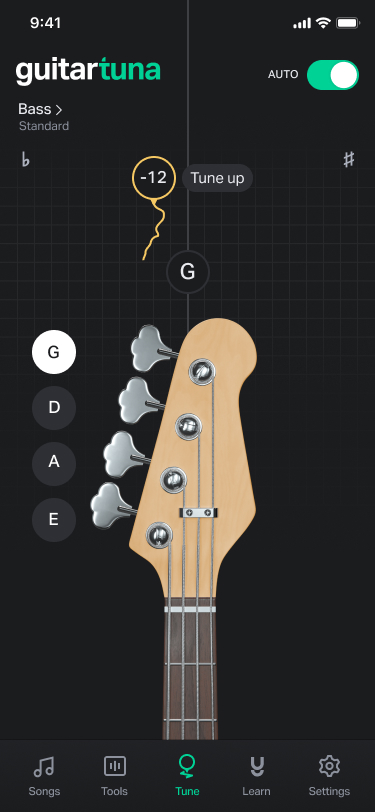Get your bass in tune with the #1 tuner
Download the GuitarTuna app to get in tune and practice like a pro anytime, anywhere. Start for free.

Join millions getting in tune with GuitarTuna



Tune your bass with the GuitarTuna app
The tuner app is the fastest, easiest, and most accurate way to tune your bass. Discover 100+ tunings including popular bass tunings, standard EADG, and more.
Improve your bass playing skills with all the tools you need including a chords library, metronome, chord trainers, and interactive games. Perfect your chord switches, train your musical ear, and memorize chord shapes.

Instant feedback for bass tuning accuracy
Getting your perfect bass tuning is easy with audio recognition technology combining with noise cancellation. The GuitarTuna tuning app listens to your pitch while you tune, guiding you with real-time feedback. Accurate and reliable, the GuitarTuna app gives you professional-quality tuning every time.

Get in tune and play your favorite songs with the #1 tuner app
Download the GuitarTuna app to access the pro-quality song library of chords and lyrics. Now on iOS and Android. Start for free.
GuitarTuna app features
-
Metronome With tap-for-tempo and multiple time signatures.
-
Chord games Plus chord library, trainers, and more.
-
Chromatic tuner With alternative and custom tunings, and manual mode to tune by ear.
-
15 instruments Tuning for stringed instruments including ukulele, bass, banjo, and more.
Get in tune anytime, anywhere, with GuitarTuna — the #1 tuner app. Download today on iOS or Android.
How to tune your bass
Follow these easy steps for beginners

Learn to play bass the fun and easy way with Yousician
Level up your playing with lessons crafted by real music teachers. Learn fast with interactive tutorials and progress tracking.

Ready to tune your bass?
Download GuitarTuna today and get all you need to practice like pro.







